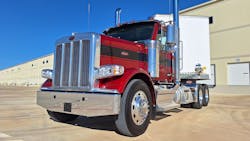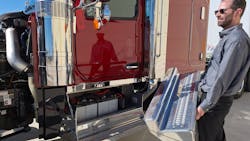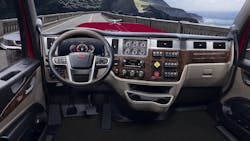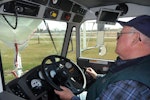Some individualistic fleet operators and gear-jammin’ drivers believe that a truck ought to look like a truck, not something that swooped down from the sky. One that has suited this crowd of old-schoolers is Peterbilt’s long line of traditionally styled conventionals that started with the Model 260 and 334 of 1939, continued with the 359 of the ’70s and early ’80s, and evolved to the 389 that just went out of production. Picking up that heritage is the new Model 589, which very much on purpose retains the older models’ Class, in keeping with the builder’s long-running advertising theme.
The 589—as retro as yesterday and as modern as tomorrow—is now being built in Denton, Texas, alongside those aerodynamic machines that appeal to more money-minded operators. The Denton plant is where I climbed into the daycab tractor, adorned in “legendary” metallic red-and-black, and took off for a spin on four-lane expressways and two-lane farm-to-market roads in the vicinity.
My guide was Jake White (right), the builder’s director of product marketing and before that a mechanical engineer, who helped design the old-but-new model. The 589 project goes back to 2013, he said.
“We did not take it lightly. There’s a lot of emotion, passion, and lifestyle around it. … It should still look like a Peterbilt coming down the road.”
Of course, the cab incorporates modern technology, such as digital instruments that can be changed to suit owner and driver. If something’s wrong, an appropriate gauge will pop up to alert the driver. One item that can’t be changed is a combined, circular digital speedometer and tachometer; engine rpm are tracked by a needle around the gauge’s perimeter while road speed is displayed as a central number. I wasn’t crazy about it because I had to peer at the small tach needle instead of just glancing at it, as I would with a separate tach and speedo.
The HVAC system features automatic operation, but three large rotary knobs are still there on the dash so a driver can take climate comfort into his own fingers. This 589 had the optional Bendix Wingman Fusion system that includes collision avoidance warning and automatic emergency braking, adaptive cruise control, and lane-keeping assist. Out on the road I didn’t notice cruise control reducing speed for slower moving traffic because we didn’t encounter much of it, and when we did I shut it off. The buzzing lane-change warnings sounded several times when I failed to signal a lane change, but I have become used to such nannying by now. And thankfully, I never tested the auto-braking system. By the way, air disc brakes were fitted to all six wheels, and they were strong.
Stopping is one thing and going is another. This tractor had the standard Paccar MX-13 diesel with the top rating of 510 horsepower and a compression brake that aided downhill retardation. On our short trek with a gross combination weight of about 65,000 pounds over mostly flat terrain and gentle upgrades, 510 was more than adequate. For extra-heavy loadings and possibly longer service life, and perhaps an emotional link to big-bore engine tradition, Cummins’ X15 with up to 605 horses is also available.
The transmission was an Eaton Fuller 18-speed manual. White said that 75% to 80% of vocationally oriented daycabs like this are ordered with manuals, suiting guys who want reliability and prefer to shift for themselves. By comparison, almost 100% of Peterbilt over-the-road tractors now leave the factory with automated manuals, primarily for their better fuel economy. It had been maybe five years since I had driven a manual and sadly, I had lost any magic touch I might have had.
First, I found it difficult to master the power-assisted clutch that engaged fairly high in the pedal travel but disengaged farther down. I did learn to back off from the accelerator just prior to declutching but wasn’t good at it. Also, while the involute gear design that Eaton adopted some years ago increases efficiency—the gears’ spiral profile keeps them meshed longer for better quietness and torque transfer—but makes them harder to shift. That’s my theory/alibi, anyway. A few hours previous I drove a sleeper-cab 589 with the same MX diesel but a TX-18 automated gearbox. That, or a 12-speed TX, is what I would order.
Otherwise, this was a fun trip. The 589 was quiet and smooth riding, turned fairly well through tight right-hand street corners, and outward visibility was superb. Notable here was the huge one-piece windshield and large side and rear windows, as well as big West Coast mirrors that now have 2 inches more height. These weren’t remotely adjustable, but motorized mirrors are going on production trucks, White said.
Now, as beautiful as the 589 is, it didn’t seem to grab much attention from the working and motoring public. I’m guessing that it went unnoticed because it looked like the many “Petercars” that have been plying North American streets and highways for so many years. Ho-hum from Joe and Jane Public, then, but you can bet that copies of this model will catch the eyes of discerning drivers at truck stops and visitors to truck shows when 589s begin appearing in numbers.








